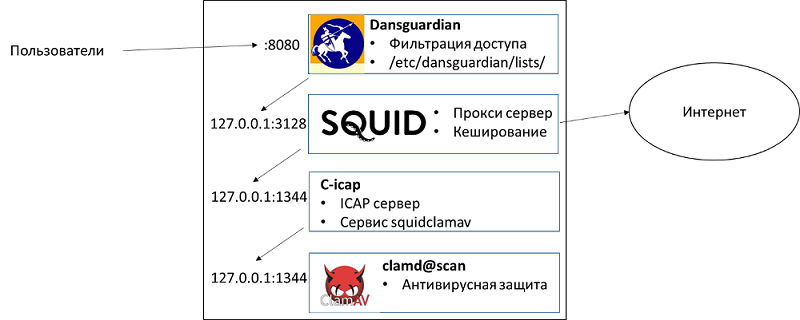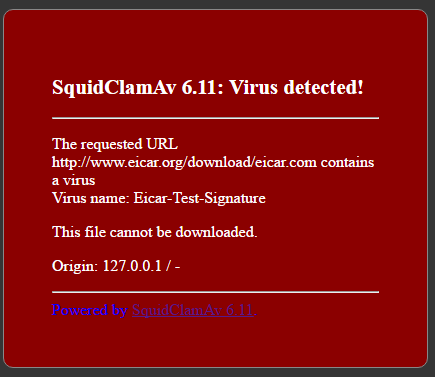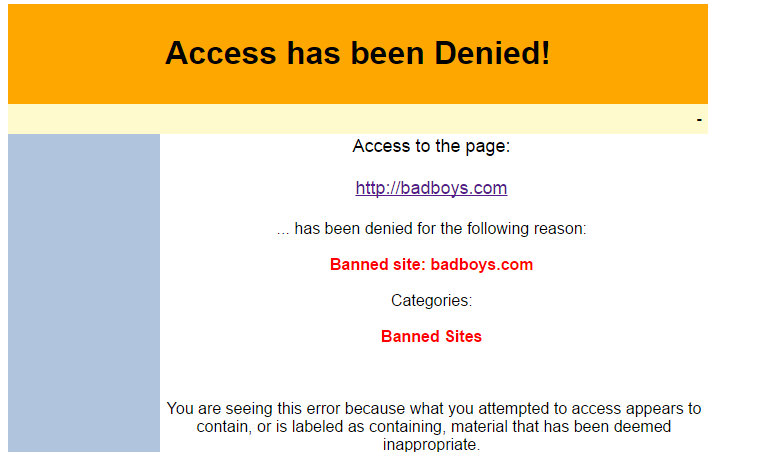Цель статьи
В Интернете доступно некоторое количество статей по настройке антивирусной защиты в связке squid + ClamAV, но нет полного материала по настройке полной связки под CentOS 7. В рамках данной статьи будет показан процесс настройки прокси сервера со следующими возможностями:
- фильтрация сайтов и ссылок по категориям;
- антивирусная защита.
Аудитория
Системные администраторы Linux

Введение
Большая часть операторов связи сейчас уже предоставляют маршрутизируемый доступ в Интернет, где фильтрация и антивирусная защита входящего траффика несколько более проблематична. В случаях, когда требуется ограничить пользователям доступ к определенным сайтам по категориям или по URL, а также требуется реализация проверки входящего веб-трафика, то в этом варианте использование прокси сервера является самым простым решением.
Squid на сегодняшний день является наиболее функциональным прокси сервером, который поддерживает большое количество возможностей. Для реализации антивирусной защиты предлагается использовать ClamAV – открытая реализация средств антивирусной защиты. Фильтрация контента по категориям будет реализована средствами Dansguardian.
Общая диаграмма решения схематично отражена ниже:

Исходные данные
У нас есть Linux сервер под управлением CentOS 7. Сервер имеет маршрутизируемый доступ в Интернет.
Базовая настройка squid
- Обновляем пакеты в системе
# yum update –y
# reboot (если требуется)
- Подключаем EPEL репозиторий, который нам понадобится для дополнительных пакетов
# yum -y install epel-release- Устанавливаем пакеты для squid
# yum -y install squid- Настраиваем конфигурационный файл /etc/squid/squid.conf (никакие изменения не требуются на данном этапе). Детальная настройка squid (ACL, авторизация и тп) находится за пределами данной статьи. Здесь мы используем конфигурационный файл, предоставляемый
пакетом по умолчанию
# egrep -v "^$|^#" /etc/squid/squid.conf acl localnet src 10.0.0.0/8 # RFC1918 possible internal network acl localnet src 172.16.0.0/12 # RFC1918 possible internal network acl localnet src 192.168.0.0/16 # RFC1918 possible internal network acl localnet src fc00::/7 # RFC 4193 local private network range acl localnet src fe80::/10 # RFC 4291 link-local (directly plugged) machines acl SSL_ports port 443 acl Safe_ports port 80 # http acl Safe_ports port 21 # ftp acl Safe_ports port 443 # https acl Safe_ports port 70 # gopher acl Safe_ports port 210 # wais acl Safe_ports port 1025-65535 # unregistered ports acl Safe_ports port 280 # http-mgmt acl Safe_ports port 488 # gss-http acl Safe_ports port 591 # filemaker acl Safe_ports port 777 # multiling http acl CONNECT method CONNECT http_access deny !Safe_ports http_access deny CONNECT !SSL_ports http_access allow localhost manager http_access deny manager http_access allow localnet http_access allow localhost http_access deny all http_port 3128 coredump_dir /var/spool/squid refresh_pattern ^ftp: 1440 20% 10080 refresh_pattern ^gopher: 1440 0% 1440 refresh_pattern -i (/cgi-bin/|?) 0 0% 0 refresh_pattern . 0 20% 4320
- Запускаем squid
# systemctl enable squid
Created symlink from /etc/systemd/system/multi-user.target.wants/squid.service to /usr/lib/systemd/system/squid.service.
# systemctl start squidНастройка сервисов антивирусной проверки ClamAV
- Устанавливаем необходимые пакеты
# yum install clamav clamav-update clamav-scanner clamav-scanner-systemd -y- Правим конфигурационный файл.
Здесь
# diff -u /etc/clamd.d/scan.conf.orig /etc/clamd.d/scan.conf --- /etc/clamd.d/scan.conf.orig 2016-07-19 22:39:26.247090604 +0300 +++ /etc/clamd.d/scan.conf 2016-07-20 02:18:16.753828514 +0300 @@ -5,13 +5,13 @@ # Comment or remove the line below. -Example +#Example # Uncomment this option to enable logging. # LogFile must be writable for the user running daemon. # A full path is required. # Default: disabled -#LogFile /var/log/clamd.scan +LogFile /var/log/clamd.scan # By default the log file is locked for writing - the lock protects against # running clamd multiple times (if want to run another clamd, please @@ -63,11 +63,11 @@ # This option allows you to save a process identifier of the listening # daemon (main thread). # Default: disabled -#PidFile /var/run/clamd.scan/clamd.pid +PidFile /var/run/clamd.scan/clamd.pid # Optional path to the global temporary directory. # Default: system specific (usually /tmp or /var/tmp). -#TemporaryDirectory /var/tmp +TemporaryDirectory /var/tmp # Path to the database directory. # Default: hardcoded (depends on installation options) @@ -82,7 +82,7 @@ # Path to a local socket file the daemon will listen on. # Default: disabled (must be specified by a user) -#LocalSocket /var/run/clamd.scan/clamd.sock +LocalSocket /var/run/clamd.scan/clamd.sock # Sets the group ownership on the unix socket. # Default: disabled (the primary group of the user running clamd) @@ -98,7 +98,7 @@ # TCP port address. # Default: no -#TCPSocket 3310 +TCPSocket 3310 # TCP address. # By default we bind to INADDR_ANY, probably not wise. @@ -106,7 +106,7 @@ # from the outside world. This option can be specified multiple # times if you want to listen on multiple IPs. IPv6 is now supported. # Default: no -#TCPAddr 127.0.0.1 +TCPAddr 127.0.0.1 # Maximum length the queue of pending connections may grow to. # Default: 200показана разница с оригинальным файлом
- Создаем необходимые файлы для работы
# touch /var/log/clamd.scan
# chown clamscan. /var/log/clamd.scan- Настраиваем обновление антивирусных баз
# diff -u /etc/freshclam.conf.orig /etc/freshclam.conf
--- /etc/freshclam.conf.orig 2016-07-19 22:47:25.195704610 +0300
+++ /etc/freshclam.conf 2016-07-19 22:47:57.103230225 +0300
@@ -5,7 +5,7 @@
# Comment or remove the line below.
-Example
+#Example
# Path to the database directory.
# WARNING: It must match clamd.conf's directive!
@@ -14,7 +14,7 @@
# Path to the log file (make sure it has proper permissions)
# Default: disabled
-#UpdateLogFile /var/log/freshclam.log
+UpdateLogFile /var/log/freshclam.log
# Maximum size of the log file.
# Value of 0 disables the limit.
@@ -48,7 +48,7 @@
# This option allows you to save the process identifier of the daemon
# Default: disabled
-#PidFile /var/run/freshclam.pid
+PidFile /var/run/freshclam.pid
# By default when started freshclam drops privileges and switches to the
# "clamav" user. This directive allows you to change the database owner.- Обновляем базы
# freshclam
ClamAV update process started at Tue Jul 19 19:48:31 2016
main.cvd is up to date (version: 57, sigs: 4218790, f-level: 60, builder: amishhammer)
connect_error: getsockopt(SO_ERROR): fd=5 error=111: Connection refused
Can't connect to port 80 of host database.clamav.net (IP: 208.72.56.53)
Trying host database.clamav.net (64.6.100.177)...
WARNING: getfile: daily-21724.cdiff not found on database.clamav.net (IP: 64.6.100.177)
WARNING: getpatch: Can't download daily-21724.cdiff from database.clamav.net
WARNING: getfile: daily-21724.cdiff not found on database.clamav.net (IP: 64.22.33.90)
WARNING: getpatch: Can't download daily-21724.cdiff from database.clamav.net
Trying host database.clamav.net (150.214.142.197)...
WARNING: getfile: daily-21724.cdiff not found on database.clamav.net (IP: 150.214.142.197)
WARNING: getpatch: Can't download daily-21724.cdiff from database.clamav.net
WARNING: Incremental update failed, trying to download daily.cvd
Downloading daily.cvd [100%]
daily.cvd updated (version: 21933, sigs: 441430, f-level: 63, builder: neo)
Downloading bytecode-279.cdiff [100%]
Downloading bytecode-280.cdiff [100%]
Downloading bytecode-281.cdiff [100%]
Downloading bytecode-282.cdiff [100%]
Downloading bytecode-283.cdiff [100%]
bytecode.cld updated (version: 283, sigs: 53, f-level: 63, builder: neo)
Database updated (4660273 signatures) from database.clamav.net (IP: 69.12.162.28)- Проверяем, что работает
# wget http://www.eicar.org/download/eicar.com
# clamscan --infected --remove --recursive eicar.com
eicar.com: Eicar-Test-Signature FOUND
eicar.com: Removed.
----------- SCAN SUMMARY -----------
Known viruses: 4654877
Engine version: 0.99.2
Scanned directories: 0
Scanned files: 1
Infected files: 1
Data scanned: 0.00 MB
Data read: 0.00 MB (ratio 0.00:1)
Time: 8.958 sec (0 m 8 s)- Запускаем демон
# systemctl start clamd@scan
# systemctl enable clamd@scan
Created symlink from /etc/systemd/system/multi-user.target.wants/clamd@scan.service to /usr/lib/systemd/system/clamd@scan.service.- Активируем автоматические обновление баз
# vi /etc/sysconfig/freshclam
Удаляем записи
### !!!!! REMOVE ME !!!!!!
### REMOVE ME: By default, the freshclam update is disabled to avoid
### REMOVE ME: network access without prior activation
FRESHCLAM_DELAY=disabled-warn # REMOVE MEСборка пакетов под CentOS 7 (на другой рабочей станции)
Я не смог найти пакетов c-icap, squidclamav и danguardian в стандартных репозиториях для CentOS 7. По этой причине пришлось собрать из src.rpm пакетов. Сборка производилась на другой рабочей станции. Разумеется, сборку под root лучше не производить.
- Собираем c-icap
# wget ftp://ftp.pbone.net/mirror/ftp5.gwdg.de/pub/opensuse/repositories/home%3A/Kenzy%3A/packages/CentOS_7/src/c-icap-0.3.5-3.1.src.rpm
# rpm –ivh c-icap-0.3.5-3.1.src.rpm
# rpmbuild -bb /root/rpmbuild/SPECS/c-icap.spec- Собираем dansguardian
# wget ftp://ftp.pbone.net/mirror/ftp5.gwdg.de/pub/opensuse/repositories/home%3A/Kenzy%3A/packages/CentOS_7/src/dansguardian-2.12.0.3-1.1.src.rpm
# rpmbuild -bb /root/rpmbuild/SPECS/dansguardian.spec- Собираем squidclamav
# wget ftp://ftp.pbone.net/mirror/ftp5.gwdg.de/pub/opensuse/repositories/home%3A/Kenzy%3A/packages/CentOS_7/src/squidclamav-6.11-2.1.src.rpm
# rpmbuild –bb /root/rpmbuild/SPECS/squidclamav.spec- Далее необходимо выложить пакеты из папки /root/rpmbuild/RPMS/x86_64 в общедоступное место
Настройка c-icap и squidclamav
- Устанавливаем пакеты для работы c-icap (пакеты были собраны ранее)
# rpm -ivh c-icap-0.3.5-3.1.x86_64.rpm libicapapi3-0.3.5-3.1.x86_64.rpm- Редактируем конфигурационный файл (нужно добавить “Service squidclamav squidclamav.so” и отредактировать параметры производительности)
# diff –ru /etc/c-icap/c-icap.conf.orig /etc/c-icap/c-icap.conf
--- /etc/c-icap/c-icap.conf.orig 2016-07-19 23:29:47.764949235 +0300
+++ /etc/c-icap/c-icap.conf 2016-07-21 02:53:24.650555236 +0300
@@ -55,7 +55,7 @@
# generates a number of threads, which serve the requests.
# Default:
# StartServers 3
-StartServers 3
+StartServers 10
# TAG: MaxServers
# Format: MaxServers number
@@ -63,7 +63,7 @@
# The maximum allowed number of server processes.
# Default:
# MaxServers 10
-MaxServers 10
+MaxServers 70
# TAG: MinSpareThreads
# Format: MinSpareThreads number
@@ -72,7 +72,7 @@
# the c-icap server starts a new child.
# Default:
# MinSpareThreads 10
-MinSpareThreads 10
+MinSpareThreads 20
# TAG: MaxSpareThreads
# Format: MaxSpareThreads number
@@ -81,7 +81,7 @@
# the c-icap server kills a child.
# Default:
# MaxSpareThreads 20
-MaxSpareThreads 20
+MaxSpareThreads 50
# TAG: ThreadsPerChild
# Format: ThreadsPerChild number
@@ -89,7 +89,7 @@
# The number of threads per child process.
# Default:
# ThreadsPerChild 10
-ThreadsPerChild 10
+ThreadsPerChild 50
# TAG: MaxRequestsPerChild
# Format: MaxRequestsPerChild number
@@ -175,7 +175,7 @@
# The acceptable range of levels is between 0 and 10.
# Default:
# DebugLevel 1
-DebugLevel 1
+DebugLevel 0
# TAG: Pipelining
# Format: Pipelining on|off
@@ -466,7 +466,8 @@
# information about the c-icap server.
# Default:
# ServerLog /var/log/c-icap/server.log
-ServerLog /var/log/c-icap/server.log
+# Disabled
+######ServerLog /var/log/c-icap/server.log
# TAG: AccessLog
# Format: AccessLog LogFile [LogFormat] [[!]acl1] [[!]acl2] [...]
@@ -481,7 +482,8 @@
# AccessLog /var/log/c-icap/access.log
# Example:
# AccessLog /var/log/c-icap/access.log MyFormat all
-AccessLog /var/log/c-icap/access.log
+# Disabled
+#########AccessLog /var/log/c-icap/access.log
# TAG: Logger
# Format: Logger LoggerName
@@ -559,7 +561,7 @@
# Simple test service
# Example:
# Service echo srv_echo.so
-Service echo srv_echo.so
+Service squidclamav squidclamav.so
# Module: sys_logger
# Description:- Редактируем систему для правильной установки права на временные файлы
# echo "d /var/run/c-icap 0755 c-icap c-icap -" >/etc/tmpfiles.d/c-icap.conf- Создаем сервис для systemd
cat <<EOF > /usr/lib/systemd/system/c-icap.service
# create new
[Unit]
Description=c-icap service
After=network.target
[Service]
Type=forking
PIDFile=/var/run/c-icap/c-icap.pid
ExecStart=/usr/bin/c-icap -f /etc/c-icap/c-icap.conf
KillMode=process
[Install]
WantedBy=multi-user.target
EOF- Устанавливаем squidclamav через yum, так как он потянет зависимости
# yum localinstall squidclamav-6.11-2.1.x86_64.rpm- Редактируем конфигурационный файл. Здесь важно, чтобы squidguard был закомментирован
# diff -u /etc/squidclamav.conf.orig /etc/squidclamav.conf
--- /etc/squidclamav.conf.orig 2016-07-19 23:52:25.927974080 +0300
+++ /etc/squidclamav.conf 2016-07-21 02:43:17.838443019 +0300
@@ -18,14 +18,15 @@
# Path to the squiGuard binary if you want URL filtering, note that you'd better
# use the squid configuration directive 'url_rewrite_program' instead.
-#squidguard /usr/sbin/squidGuard
+#squidguard /usr/bin/squidGuard
# Path to the clamd socket, use clamd_local if you use Unix socket or if clamd
# is listening on an Inet socket, comment clamd_local and set the clamd_ip and
# clamd_port to the corresponding value.
-clamd_local /var/run/clamav/clamd-socket
-#clamd_ip 192.168.1.5,127.0.0.1
-#clamd_port 3310
+#clamd_local /var/run/clamd.scan/clamd.sock
+clamd_ip 127.0.0.1
+clamd_port 3310
+trust_cache 0
# Set the timeout for clamd connection. Default is 1 second, this is a good
# value but if you have slow service you can increase up to 3.- ВНИМАНИЕ! При активации опции squidguard сервис squidclamav не сможет инициализироваться
- Запускаем сервис c-icap
# mkdir /var/run/c-icap
# chown c-icap /var/run/c-icap
# systemctl enable c-icap
# systemctl start c-icapНастройка интеграции squid с c-icap
- Добавляем в конец конфигурационного файла squid
# cat <<EOF >> /etc/squid/squid.conf
# c-icap integration
icap_enable on
icap_send_client_ip on
icap_send_client_username on
icap_client_username_header X-Authenticated-User
icap_service service_req reqmod_precache bypass=1 icap://127.0.0.1:1344/squidclamav
adaptation_access service_req allow all
icap_service service_resp respmod_precache bypass=1 icap://127.0.0.1:1344/squidclamav
adaptation_access service_resp allow all
# end integration
EOF- Перезапускаем squid
# systemctl restart squidНастройка squidGuard
- Мне не удалось поднять этот сервис, так как при указанном в squidclamav c-icap сообщал об ошибке инициализации squidclamav. Возможно, в других ОС или с другими опциями компиляции это будет работать
- Устанавливаем squidGuard
# yum install squidGuard –y- Правим конфигурационный файл /etc/squid/squidGuard.conf
# egrep -v "^#|^$" /etc/squid/squidGuard.conf
dbhome /var/squidGuard/blacklists
logdir /var/log/squidGuard
time workhours {
weekly mtwhf 08:00 - 16:30
date *-*-01 08:00 - 16:30
}
rew dmz {
s@://admin/@://admin.foo.bar.de/@i
s@://foo.bar.de/@://www.foo.bar.de/@i
}
dest deny {
domainlist deny/domains
urllist deny/urls
}
acl {
default {
pass !deny all
redirect http://admin.foo.bar.de/cgi/blocked?clientaddr=%a+clientname=%n+clientuser=%i+clientgroup=%s+targetgroup=%t+url=%u
}
}- Создаем необходимые файлы для работы
# mkdir –p /var/squidGuard/blacklists/deny
# cat /var/squidGuard/blacklists/deny/domains
yahoo.co.in
example.com
# cat /var/squidGuard/blacklists/deny/urls
#write URLs you’d like to prohibit to access
http://www.yahoo.co.in
http://www.sathish.com- Пересобираем базу
# chown -R squid. /var/squidGuard/blacklists/deny/
# squidGuard -C all- Проверяем, что данные доступны
# ls -l /var/squidGuard/blacklists/deny/*.db
-rw-r--r--. 1 root root 8192 Jul 19 22:09 /var/squidGuard/blacklists/deny/domains.db
-rw-r--r--. 1 root root 8192 Jul 19 22:09 /var/squidGuard/blacklists/deny/urls.db
# file /var/squidGuard/blacklists/deny/domains.db
/var/squidGuard/blacklists/deny/domains.db: Berkeley DB (Btree, version 9, native byte-order)Настройка dansguarian
- Устанавливаем dansguardian (был собран ранее)
# rpm -ivh dansguardian-2.12.0.3-1.1.x86_64.rpm- Правим конфигурационный файл
# vi /etc/dansguardian/dansguardian.conf
…
accessdeniedaddress = 'http://127.0.0.1/cgi-bin/dansguardian.pl'
…- Добавляем в автозагрузку и запускаем
# /etc/init.d/dansguardian start
# chkconfig dansguardian on- Если требуется, то можем настроить категории и
списки фильтрации
# ls -l /etc/dansguardian/lists/ total 140 drwxr-xr-x. 2 root root 21 Jul 20 01:13 authplugins -rw-r--r--. 1 root root 4950 Jul 20 01:38 bannedextensionlist -rw-r--r--. 1 root root 500 Jul 19 21:15 bannediplist -rw-r--r--. 1 root root 284 Jul 19 21:15 bannedmimetypelist -rw-r--r--. 1 root root 1958 Jul 19 21:15 bannedphraselist -rw-r--r--. 1 root root 321 Jul 19 21:15 bannedregexpheaderlist -rw-r--r--. 1 root root 5229 Jul 19 21:15 bannedregexpurllist drwxr-xr-x. 2 root root 20 Jul 20 01:13 bannedrooms -rw-r--r--. 1 root root 4985 Jul 19 21:15 bannedsitelist -rw-r--r--. 1 root root 2640 Jul 19 21:15 bannedurllist drwxr-xr-x. 3 root root 16 Jul 20 01:13 blacklists -rw-r--r--. 1 root root 4979 Jul 19 21:15 contentregexplist drwxr-xr-x. 2 root root 4096 Jul 20 01:13 contentscanners drwxr-xr-x. 2 root root 59 Jul 20 01:13 downloadmanagers -rw-r--r--. 1 root root 480 Jul 19 21:15 exceptionextensionlist -rw-r--r--. 1 root root 912 Jul 19 21:15 exceptionfilesitelist -rw-r--r--. 1 root root 834 Jul 19 21:15 exceptionfileurllist -rw-r--r--. 1 root root 708 Jul 19 21:15 exceptioniplist -rw-r--r--. 1 root root 653 Jul 19 21:15 exceptionmimetypelist -rw-r--r--. 1 root root 538 Jul 19 21:15 exceptionphraselist -rw-r--r--. 1 root root 335 Jul 19 21:15 exceptionregexpurllist -rw-r--r--. 1 root root 1275 Jul 19 21:15 exceptionsitelist -rw-r--r--. 1 root root 361 Jul 19 21:15 exceptionurllist -rw-r--r--. 1 root root 194 Jul 19 21:15 filtergroupslist -rw-r--r--. 1 root root 1910 Jul 19 21:15 greysitelist -rw-r--r--. 1 root root 902 Jul 19 21:15 greyurllist -rw-r--r--. 1 root root 616 Jul 19 21:15 headerregexplist -rw-r--r--. 1 root root 623 Jul 19 21:15 logregexpurllist -rw-r--r--. 1 root root 596 Jul 19 21:15 logsitelist -rw-r--r--. 1 root root 591 Jul 19 21:15 logurllist drwxr-xr-x. 36 root root 4096 Jul 20 01:13 phraselists -rw-r--r--. 1 root root 2743 Jul 19 21:15 pics -rw-r--r--. 1 root root 2887 Jul 19 21:15 urlregexplist -rw-r--r--. 1 root root 6524 Jul 19 21:15 weightedphraselist # cat /etc/dansguardian/lists/bannedsitelist |egrep -v "^#|^$" badboys.com .Include</etc/dansguardian/lists/blacklists/ads/domains>
Настройка веб сервера Apache
- Устанавливаем пакеты
# yum install httpd- Запускаем и добавляем в автозагрузку
# systemctl enable httpd
# systemctl start httpd- Копируем скрипты от squidclamav в CGI директорию
# cp /srv/www/cgi-bin/clwarn.cgi* /var/www/cgi-bin/Проверка работоспособности
- Прописываем параметры прокси сервера у себя в веб-брауззере
— Адрес: маршрутизируемый адрес вашего сервера
— Порт: 8080 (порт Dansguardian) - Пробуем подключаться к веб-сайтам (должно работать)
- Пробуем скачать тестовый вирус eicar. Здесь вы должны увидеть следующее сообщение:

- Пробуем открыть запрещенные ссылки (http://badboys.com). Должны увидеть следующее сообщение от Dansguardian:

Заключение
Данная статья показывает, что настройка связки прокси сервера squid с антивирусным ПО ClamAV является несложным занятием, которое под силу даже начинающему администратору Linux/Unix.
Автор artemii
Автор: Bell Integrator






